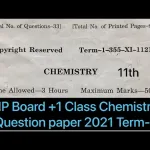Chemistry is an essential subject for students in the 11th grade under the HP Board. Understanding the concepts thoroughly can make a significant difference in academic performance. Top questions and answers to help students prepare for their 2017 chemistry exams.
HP Board 11th Class Chemistry Question Paper 2017 With Answers
Question: What is the atomic number of Carbon?
Answer: The atomic number of Carbon is 6.
Question: Explain the term ‘isotope’.
Answer: Isotopes are atoms of the same element that have different numbers of neutrons.
Question: Define ionization energy.
Answer: Ionization energy is the energy required to remove an electron from an atom in its gaseous state.
Question: What is the chemical formula for water?
Answer: The chemical formula for water is H₂O.
Question: Explain the law of conservation of mass.
Answer: The law of conservation of mass states that mass cannot be created or destroyed in a chemical reaction.
Question: Describe what is meant by the term ‘mole’ in chemistry.
Answer: A mole is a unit that measures the amount of substance, containing Avogadro’s number of particles (6.022 x 10²³ particles).
Question: What are valence electrons?
Answer: Valence electrons are the electrons in the outermost shell of an atom that are involved in chemical bonding.
Question: Explain the concept of hybridization.
Answer: Hybridization is the process of combining atomic orbitals to form new hybrid orbitals suitable for pairing electrons to form chemical bonds.
Question: What is the pH scale?
Answer: The pH scale measures the acidity or basicity of a solution, ranging from 0 to 14.
Question: Define an exothermic reaction.
Answer: An exothermic reaction is a chemical reaction that releases energy, usually in the form of heat.
Question: What is Avogadro’s law?
Answer: Avogadro’s law states that equal volumes of gases, at the same temperature and pressure, contain an equal number of molecules.
Question: Describe the structure of an atom.
Answer: An atom consists of a nucleus, containing protons and neutrons, surrounded by electrons in orbitals.
Question: What is the difference between ionic and covalent bonds?
Answer: Ionic bonds involve the transfer of electrons between atoms, while covalent bonds involve the sharing of electrons.
Question: Explain what is meant by ‘electronegativity’.
Answer: Electronegativity is the tendency of an atom to attract electrons towards itself in a chemical bond.
Question: What is a catalyst?
Answer: A catalyst is a substance that speeds up a chemical reaction without being consumed in the process.
Question: Define oxidation and reduction.
Answer: Oxidation is the loss of electrons, and reduction is the gain of electrons in a chemical reaction.
Question: What is the chemical symbol for Sodium?
Answer: The chemical symbol for Sodium is Na.
Question: Explain the term ‘enthalpy’.
Answer: Enthalpy is the total heat content of a system at constant pressure.
Question: What is meant by the periodic table?
Answer: The periodic table is a tabular arrangement of chemical elements, ordered by their atomic number, electron configurations, and recurring chemical properties.
Question: Describe the concept of molecular geometry.
Answer: Molecular geometry refers to the three-dimensional arrangement of atoms within a molecule.
Question: What is the difference between a mixture and a compound?
Answer: A mixture is a combination of two or more substances that are not chemically bonded, while a compound is a substance formed when two or more elements are chemically bonded.
Question: Define molarity.
Answer: Molarity is a measure of the concentration of a solute in a solution, expressed as moles of solute per liter of solution.
Question: What is a chemical equilibrium?
Answer: Chemical equilibrium is a state in which the rate of the forward reaction equals the rate of the reverse reaction, and the concentrations of reactants and products remain constant.
Question: Explain what is meant by ‘Le Chatelier’s Principle’.
Answer: Le Chatelier’s Principle states that if a dynamic equilibrium is disturbed by changing the conditions, the position of equilibrium moves to counteract the change.
Question: What is an acid and a base?
Answer: An acid is a substance that donates protons (H⁺ ions), and a base is a substance that accepts protons.
Question: What is the difference between endothermic and exothermic reactions?
Answer: Endothermic reactions absorb energy from the surroundings, while exothermic reactions release energy.
Question: Explain the concept of a chemical bond.
Answer: A chemical bond is the force that holds atoms together in a molecule or compound.
Question: What is the importance of the octet rule?
Answer: The octet rule states that atoms tend to form bonds in such a way that they have eight electrons in their valence shell, achieving a stable configuration similar to noble gases.
Question: Describe the process of electrolysis.
Answer: Electrolysis is a chemical process that uses electricity to cause a non-spontaneous reaction to occur, typically involving the decomposition of a compound.
Question: What is a buffer solution?
Answer: A buffer solution is a solution that resists changes in pH when small amounts of an acid or base are added.
Question: Define the term ‘stoichiometry’.
Answer: Stoichiometry is the calculation of reactants and products in chemical reactions based on the conservation of mass.
Question: What is the role of a solvent in a solution?
Answer: A solvent is the substance in which a solute is dissolved to form a solution.
Question: Explain the concept of atomic orbitals.
Answer: Atomic orbitals are regions around an atom’s nucleus where there is a high probability of finding electrons.
Question: What is a Lewis acid and a Lewis base?
Answer: A Lewis acid is a substance that can accept an electron pair, while a Lewis base is a substance that can donate an electron pair.
Question: Define the term ‘activation energy’.
Answer: Activation energy is the minimum energy required for a chemical reaction to occur.
Question: What is the chemical formula for Sodium Chloride?
Answer: The chemical formula for Sodium Chloride is NaCl.
Question: Describe what happens during a neutralization reaction.
Answer: A neutralization reaction occurs when an acid reacts with a base to form water and a salt.
Question: What is the principle behind the pH indicator?
Answer: A pH indicator is a chemical that changes color depending on the acidity or basicity of a solution.
Question: Explain what is meant by ‘quantum numbers’.
Answer: Quantum numbers describe the properties of atomic orbitals and the properties of electrons in orbitals.
Question: What is a covalent compound?
Answer: A covalent compound is a chemical compound formed by the sharing of electron pairs between atoms.
Question: Describe the difference between a saturated and an unsaturated hydrocarbon.
Answer: A saturated hydrocarbon contains only single bonds between carbon atoms, while an unsaturated hydrocarbon contains one or more double or triple bonds.
Question: What is the empirical formula?
Answer: The empirical formula of a compound is the simplest whole-number ratio of atoms of each element in the compound.
Question: Define a polar molecule.
Answer: A polar molecule has a partial positive charge on one side and a partial negative charge on the other due to the unequal sharing of electrons.
Question: What is a chemical reaction?
Answer: A chemical reaction is a process in which substances interact to form new substances with different properties.
Question: Explain what is meant by ‘isomerism’.
Answer: Isomerism refers to the existence of two or more compounds with the same molecular formula but different structures or arrangements of atoms.
Question: What is the significance of the periodic table?
Answer: The periodic table organizes elements based on their atomic number, electron configurations, and chemical properties, helping predict the behavior of elements in chemical reactions.
Question: Describe the role of water as a solvent.
Answer: Water is a universal solvent due to its polarity, which allows it to dissolve many substances by surrounding and separating their molecules or ions.
Question: What is a chemical equation?
Answer: A chemical equation represents a chemical reaction using symbols and formulas to show the reactants and products.
Question: Explain the concept of oxidation numbers.
Answer: Oxidation numbers indicate the degree of oxidation of an atom in a compound, representing the number of electrons lost or gained.
Question: What is a precipitate?
Answer: A precipitate is an insoluble solid that forms and separates from a solution during a chemical reaction.
Question: Define the term ‘enthalpy change’.
Answer: Enthalpy change is the amount of heat absorbed or released during a chemical reaction at constant pressure.
Question: What is the significance of the Avogadro constant?
Answer: The Avogadro constant represents the number of atoms, ions, or molecules in one mole of a substance, approximately 6.022 x 10²³.
Question: What is meant by the rate of reaction?
Answer: The rate of reaction is the speed at which reactants are converted into products in a chemical reaction.
Question: Explain the difference between strong and weak acids.
Answer: Strong acids completely ionize in solution, while weak acids only partially ionize.
Question: What is meant by the term ‘sublimation’?
Answer: Sublimation is the process in which a solid changes directly into a gas without passing through the liquid state.
Question: Define the term ‘catalysis’.
Answer: Catalysis is the acceleration of a chemical reaction by a catalyst.
Question: What is the molecular formula for glucose?
Answer: The molecular formula for glucose is C₆H₁₂O₆.
Question: Describe the role of enzymes in biological reactions.
Answer: Enzymes are biological catalysts that speed up chemical reactions in living organisms by lowering the activation energy.
Question: What is the difference between an element and a compound?
Answer: An element is a substance made of only one type of atom, while a compound is a substance made of two or more different types of atoms chemically bonded together.
Exam Pattern and Syllabus
Exam Pattern
The HP Board 11th Class Chemistry exam typically consists of multiple-choice questions, short answer questions, and long answer questions. The exam is divided into theoretical and practical components. The theoretical exam is usually for 70 marks, while the practical exam is for 30 marks. The total duration of the exam is 3 hours.
Syllabus
The syllabus for the HP Board 11th Class Chemistry exam includes the following topics:
- Basic Concepts of Chemistry
- Structure of Atom
- Classification of Elements and Periodicity in Properties
- Chemical Bonding and Molecular Structure
- States of Matter: Gases and Liquids
- Thermodynamics
- Equilibrium
- Redox Reactions
- Hydrogen
- s-Block Element (Alkali and Alkaline earth metals)
- Some p-Block Elements
- Organic Chemistry: Some Basic Principles and Techniques
- Hydrocarbons
- Environmental Chemistry
Understanding the basics of chemistry is essential for academic success, especially in the 11th grade. The questions and answers provided here cover key concepts that will help students prepare effectively for their exams. By practicing these questions, students can enhance their understanding and perform better in their exams
Latest Posts
- Step-by-step guide to download and apply for jee mains admit card 202
- Comprehensive 2025 government holidays and recruitment details for job seekers
- JEE Mains Admit Card 2025: Your Step-by-Step Guide to Downloading the Hall Ticket
- Everything You Need to Know About 2025 Government Holidays Recruitment
- Comprehensive Guide to rrb d group recruitment 2025 – Eligibility, Vacancies, and Application
- Detailed guide to nps trust recruitment 2025 vacancies, eligibility and apply process
- Comprehensive guide to hpcl recruitment 2025 notification, vacancies, and application process
- ignou bed admission 2025 complete recruitment guide with eligibility and process
- Comprehensive Guide to Indian Army Agniveer Recruitment 2025 Notification and Jobs
- Everything You Must Know About CBSE Board Exams 2025 Changes & New Rules





